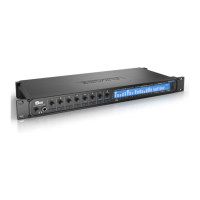
Do you have a question about the MOTU 8M and is the answer not in the manual?
| Category | Audio Interface |
|---|---|
| Interface | USB 2.0 |
| Analog Inputs | 8 |
| Analog Outputs | 8 |
| Digital Inputs | 2 x ADAT optical (16 channels @ 48kHz), 1 x RCA S/PDIF |
| Digital Outputs | 2 x ADAT optical (16 channels @ 48kHz), 1 x RCA S/PDIF |
| Sample Rates | 44.1 kHz, 48 kHz, 88.2 kHz, 96 kHz, 176.4 kHz, 192 kHz |
| Phantom Power | Yes |
| Weight | 1.8 kg |
Precautions regarding operating temperature, ventilation, and heat dispersion.
Step-by-step instructions to quickly set up and begin using the MOTU AVB interface.
Detailed descriptions of the front and rear panel controls and connectors for the 1248, 8M, and 16A.
Information on accessing and using the web application for controlling the MOTU AVB interface.
Details on analog, digital, and network I/O capabilities and audio specifications for MOTU interfaces.
Overview of universal connectivity, DSP, AVB networking, and web app control features.
Information on stand-alone operation, digital I/O, metering, and bundled AudioDesk software.
List of items included in the MOTU interface package.
Hardware and software requirements for operating the MOTU interface and included software.
Explains when software installation is needed and the benefits of USB class-compliant operation.
Details on running the installer, Core Audio drivers, Discovery app, and AudioDesk software.
Guidelines for rack installation, heat management, and initial Thunderbolt/USB setups.
Instructions for multi-interface, network, and web app control configurations.
Details on connecting audio sources and examples of typical interface setups.
Explains the importance of synchronization and how to set up clock sources for digital audio.
Overview of the preset menu and common preset types like Audio Interface and Stand-alone Mixer.
Explains presets for Live Recording, Stage I/O, Input/Output Expansion, and Optical Conversion.
Description of the LCD, level meters, front panel knobs, buttons, and focus features.
How to navigate menus, use Trim, ID, and access device, network, and other settings.
Preparation, running the web app, sample rate, clock mode, and driver selection for host software.
Mapping audio channels, configuring I/O, and reducing monitoring latency for optimal performance.
How to synchronize the audio software and MOTU interface with other system components.
Introduction to DSP effects, advantages, and explanation of High Pass Filter, Gate, and EQ.
Details on the Compressor and Leveler modules for dynamic range control.
Information on the Reverb processor, its controls, and managing DSP resources.
Introduction to AVB, its benefits, and MOTU's implementation for audio networking.
Examples of studio, concert, and large-scale networking, plus quick setup guides.
How to connect standard Ethernet devices and the role of the MOTU AVB Switch.
Troubleshooting steps for input/output problems, no audio, and routing display errors.
Solutions for monitoring issues, latency, effect overload, presets, and software authentication.
Detailed technical specifications for the 1248, 8M, and 16A audio interfaces' inputs and outputs.
Specifications for S/PDIF, Phones, Word Clock, and Power Supply across MOTU devices.
Block diagrams illustrating the signal path for mono and stereo input channels.
Block diagrams illustrating the signal path for group and monitor buses.
Guides for updating firmware via internet connection or using a downloaded file.
Information on viewing firmware versions and the requirements for the update process.
Explanation of OSC support for remote control of MOTU AVB devices and mixer functions.